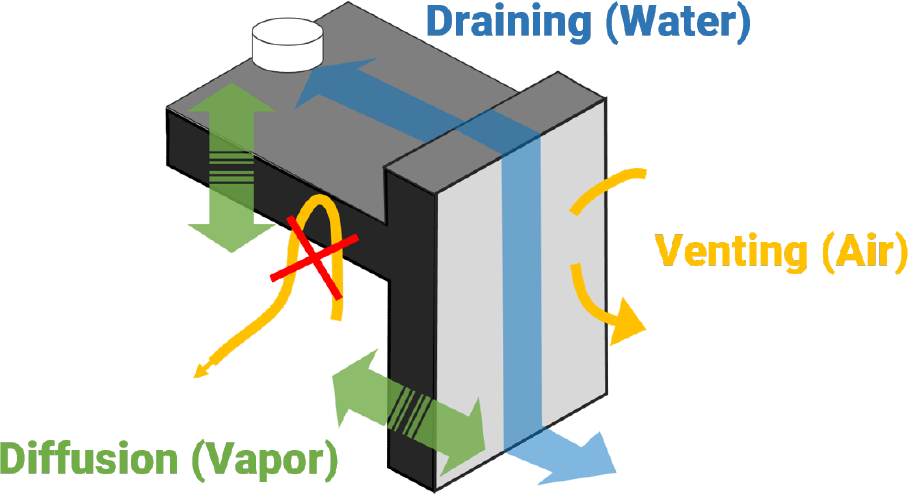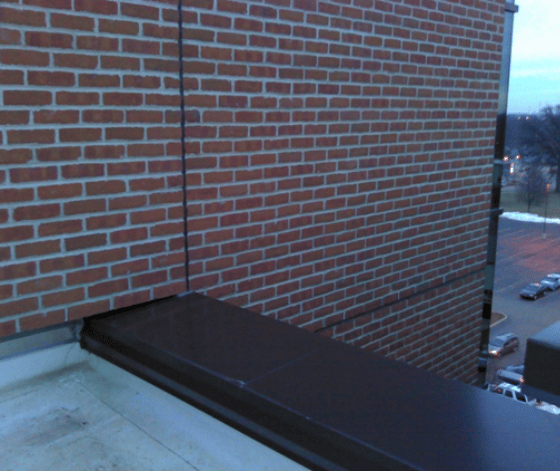
Sponsored by:
AIA Course: #BE2023GAF3
Earn: 1 AIA LU/HSW; 1 IIBEC CEH
To complete the quiz and receive a certificate of completion, follow this link: ce.buildingenclosureonline.com/BE2023GAF3
Learning Objectives:
After reading this article, you should be able to:
- Explain the building science behind building enclosure strategies for managing moisture, air, vapor, and thermal concerns.
- Recognize how control layer interface details impact meeting building performance requirements.
- Describe how to design interface details to ensure they will meet air, water, and thermal control requirements.
- Determine how to document, specify, and set installation and quality assurance requirements to ensure performance.

"Coming together is a beginning, staying together is progress, and working together is success."
– Henry Ford
Building science is, in essence, the study of the impacts of heat, air, and moisture on the building enclosure. Through the study of building science, the design professional learns how to prevent damage from air and moisture infiltration, and how to improve the overall energy efficiency, durability, and long-term performance of buildings. Rather than viewing the elements of a building as a collection of individual and unrelated components, ensuring performance of the building enclosure requires a systems perspective. Avoiding risks in a building structure requires understanding how the increasingly complex systems required in a building come together, stay together, and perform together.
The Fundamental Science of Control Layers
It is an inescapable and universal truth that natural forces are always at work on buildings. The fundamentals of building science are found in the Second Law of Thermodynamics:
- Heat will flow from warm to cold;
- Moisture will flow from warm to cold;
- Moisture will also flow from wet to dry;
- Air flows from an area of higher pressure to one with lower pressure; and
- Gravity acts down.
Energy, air, and moisture will flow between two zones until a state of equilibrium or balance is achieved. Understanding the preferred path of movement is the first step in knowing how to control the environment within a building enclosure. Image courtesy of GAF | Siplast

What are control layers?
Control layer is the term used for the parts of the building enclosure that are designed to stop external elements from moving uncontrolled through a structure. There are four main control layers in a building: they address liquid water, air, heat, and water vapor. Whether the control layer completely stops the movement of the elements or slows down the movement depends on the materials used and the needs of the building.
In essence, the four control layers can be split into two main categories: those that manage moisture and those that manage energy efficiency. Moisture management works to prevent liquid water, water vapor, and condensation from impacting the building. Managing energy efficiency focuses on the movement of air and heat through the building enclosure. All of the control layers need to work together to achieve maximum effectiveness.
Moisture management
Of the many challenges a building enclosure faces, water represents the greatest continuous threat. The presence of water in unwanted locations within the building enclosure can contribute to rot, decay, and biological growth. There are four primary ways moisture makes its way into a building and they all need to be considered when designing a building’s enclosure: flow of liquid water, capillary suction, air-transported water vapor, and diffusion.
The most obvious and impactful way is liquid water, or water from rain or snow. Buildings must be designed to efficiently manage or shed water by moving the water out and away from the structure. This is the primary role of the water control layer in the enclosure assembly.
Next is capillary action. This is how water moves through pores and small cracks, sometimes acting against gravity, and seeping into masonry, foundations, and any other tight spaces in the building.
The last two—air-transported water vapor and diffusion—can be the hardest to see. Moisture vapor transported in either manner can cause damage when it is allowed to condense or become liquid in a place where the liquid water cannot be managed. The materials and designs used to control air intrusion and reduce vapor diffusion are often less obvious. They must interact with the other building control layers, such as the air and thermal control layers, in order to perform.
The importance of a continuous air control layer to manage uncontrolled airflow, and the moisture it carries, cannot be overstated. Gaps and discontinuities in the air control layer within the building enclosure allow air and its associated moisture to enter the assembly. Air leakage can carry as much as 100 times the amount of moisture through a hole in the building enclosure when compared with the transport from vapor diffusion moving through the building materials. The amount of moisture air will hold is dependent on its temperature. Warm air can hold more moisture than cold air. When warm, moist air encounters a cold surface, the air will cool and the excess moisture that the air can no longer hold will condense on the cold surface, causing a problem if the water cannot be managed at that location.
Vapor diffusion through building materials can be less impactful because water vapor moves much slower in this manner. All materials used within the building enclosure have a permeance and will slow the movement of moisture vapor that is moving through the assembly by way of diffusion. Understanding the permeance of materials and how easily moisture vapor may flow through them—or not—is the first step in preventing issues caused by moisture moving in this manner.
Moisture management strategies. Image courtesy GAF.

Using the roof-to-wall interface as an example to illustrate moisture management strategies, the first line of defense is to drain water away by directing water to roof drains and out from the wall. The next step involves venting or using airflow to pull moisture vapor out of the building enclosure assembly. The final moisture management step is managing diffusion: allowing diffusion to dry the assembly in at least one direction, accommodating any incidental moisture in the building materials to leave the assembly. The process of diffusion is slow and should be a strategy only for incidental moisture. Ensuring moisture vapor does not become condensation and liquid water where it cannot be managed in one of these ways becomes the responsibility of the thermal control layer.
Energy efficiency management
Managing energy efficiency of buildings relies upon both preventing uncontrolled air movement and resisting heat flow. Adding more insulation to the thermal control layer could seem to provide the answer to improving energy efficiency. However, simply adding more insulation to a building envelope soon reaches the point of rapidly diminishing returns. The real culprit behind poor efficiency is air movement.
Airflow through the building envelope is the most effective method of carrying heat and moisture into or out of a building. In order for air to flow in or out of a space, there needs to be a pressure differential across the boundary and an opening for the air to move through. Buildings become pressurized due to wind, stack effect, and heating, air conditioning, and ventilation (HVAC) systems. Wind exerts pressure on the building enclosure causing positive pressure on the windward side and negative pressure on the opposite side. Stack effect is caused by warm air rising, increasing pressures higher up in the building. Any discontinuities in the air control layer, no matter how small, will provide the opening for air along with heat and moisture vapor to move through the enclosure.
Airglow through the building envelope is the most effective method of carrying heat and moisture into or out of a building as shown in the FLIR image of a rising wall detail. Images courtesy SmithGroup.




